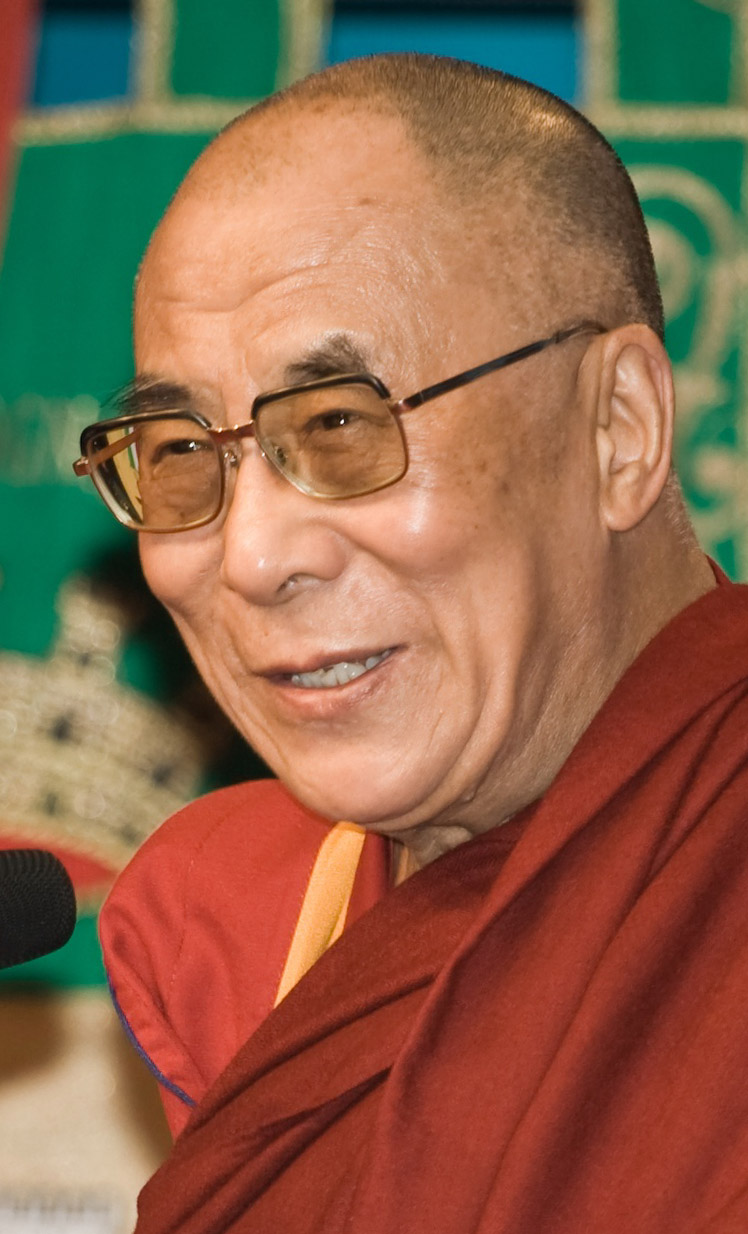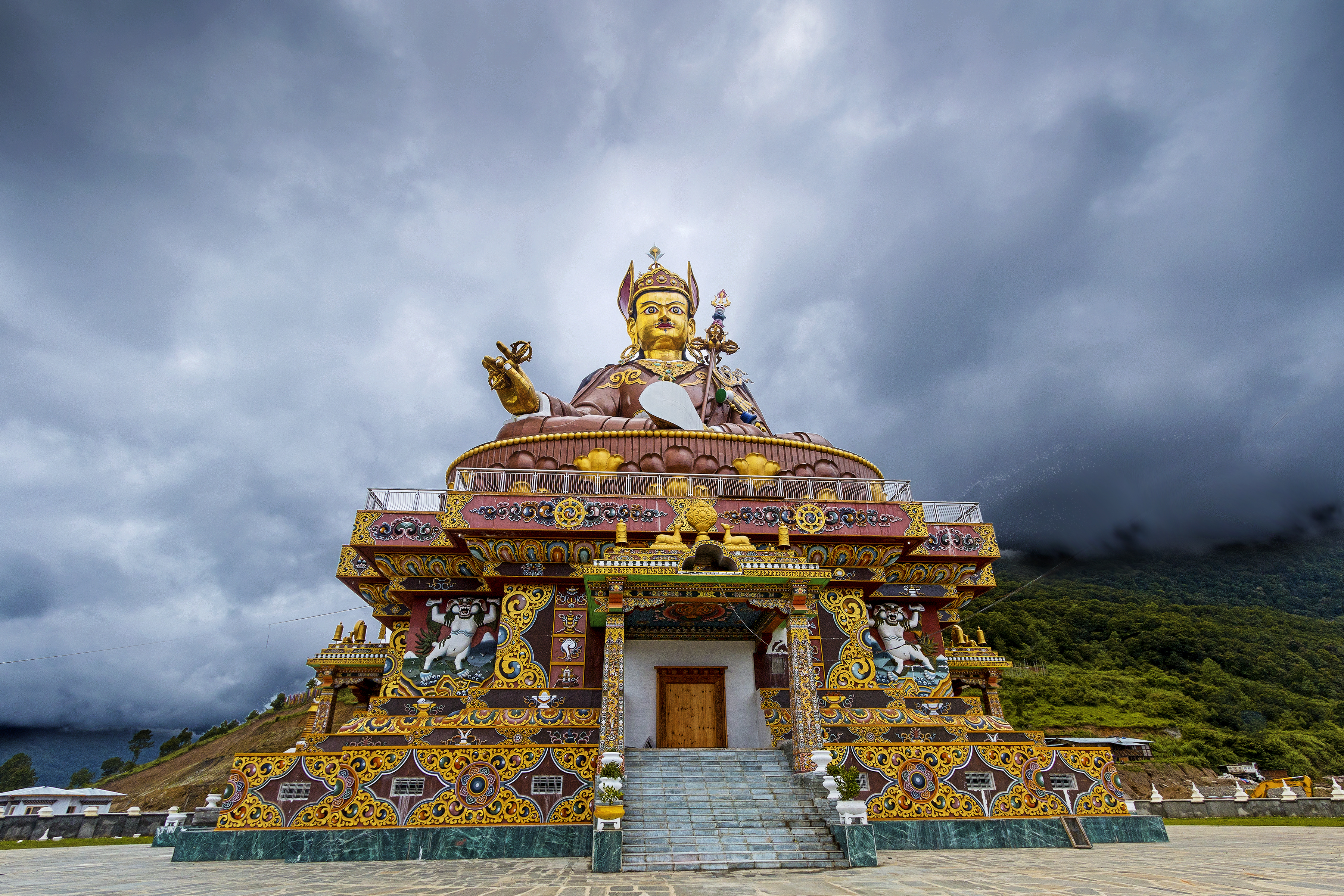|
Urgyen Tsomo
Urgyen Tsomo (1897–1961) was a prominent Tibetan Buddhist female master who was known as the Great Dakini of Tsurphu (Tsurpu Khandro Chenmo). She was the consort of the Khakyab Dorje, 15th Karmapa Lama. She was considered by other masters to be the reincarnation (emanation) of Yeshe Tsogyal, the wife of Padmasambhava of the 8th century, who spread Buddhism in Tibet. Her emanation has similarly been recognized in Mindrolling Jetsün Khandro Rinpoche. Biography Urgyen Tsomo was a young woman who lived with her family in the Tsurphu valley. According to a terma (a tradition of continuous revelation in Tibetan Buddhism), when the 15th Karmapa Lama fell sick during his old age, it was predicted that he would marry a particular person, a dakini (a type of spirit in Vajrayana Buddhism) in human form who would cure his disease and extend his life. The terma also indicated the location where such a woman would be found. Khakhyab Dorje, who had dreamed of the location where he would fi ... [...More Info...] [...Related Items...] OR: [Wikipedia] [Google] [Baidu] |
Tibet (1912–51)
Tibet (; ''Böd''; ) is a region in East Asia, covering much of the Tibetan Plateau and spanning about . It is the traditional homeland of the Tibetan people. Also resident on the plateau are some other ethnic groups such as Monpa, Tamang, Qiang, Sherpa and Lhoba peoples and now also considerable numbers of Han Chinese and Hui settlers. Since 1951, the entire plateau has been under the administration of the People's Republic of China, a major portion in the Tibet Autonomous Region, and other portions in the Qinghai and Sichuan provinces. Tibet is the highest region on Earth, with an average elevation of . Located in the Himalayas, the highest elevation in Tibet is Mount Everest, Earth's highest mountain, rising 8,848.86 m (29,032 ft) above sea level. The Tibetan Empire emerged in the 7th century. At its height in the 9th century, the Tibetan Empire extended far beyond the Tibetan Plateau, from Central Asian's Tarim Basin and the Pamirs in the ... [...More Info...] [...Related Items...] OR: [Wikipedia] [Google] [Baidu] |
Vajrayana Buddhism
Vajrayāna ( sa, वज्रयान, "thunderbolt vehicle", "diamond vehicle", or "indestructible vehicle"), along with Mantrayāna, Guhyamantrayāna, Tantrayāna, Secret Mantra, Tantric Buddhism, and Esoteric Buddhism, are names referring to Buddhist traditions associated with Tantra and "Secret Mantra", which developed in the medieval Indian subcontinent and spread to Tibet, Nepal, other Himalayan states, East Asia, and Mongolia. Vajrayāna practices are connected to specific lineages in Buddhism, through the teachings of lineage holders. Others might generally refer to texts as the Buddhist Tantras. It includes practices that make use of mantras, dharanis, mudras, mandalas and the visualization of deities and Buddhas. Traditional Vajrayāna sources say that the tantras and the lineage of Vajrayāna were taught by Śākyamuni Buddha and other figures such as the bodhisattva Vajrapani and Padmasambhava. Contemporary historians of Buddhist studies meanwhile argue that ... [...More Info...] [...Related Items...] OR: [Wikipedia] [Google] [Baidu] |
His Eminence
His Eminence (abbreviation H.Em. or H.E. or HE) is a style of reference for high nobility, still in use in various religious contexts. Catholicism The style remains in use as the official style or standard form of address in reference to a cardinal of the Catholic Church, reflecting his status as a Prince of the Church. A longer, and more formal, title is "His (or Your when addressing the cardinal directly) Most Reverend Eminence". Patriarchs of Eastern Catholic Churches who are also cardinals may be addressed as "His Eminence" or by the style particular to Catholic patriarchs, His Beatitude. When the Grand Master of the Sovereign Military Order of Malta, the head of state of their sovereign territorial state comprising the island of Malta until 1797, who had already been made a Reichsfürst (i.e., prince of the Holy Roman Empire) in 1607, became (in terms of honorary order of precedence, not in the actual church hierarchy of ordained ministers) the most senior offic ... [...More Info...] [...Related Items...] OR: [Wikipedia] [Google] [Baidu] |
Rangjung Rigpe Dorje, 16th Karmapa
The sixteenth Gyalwa Karmapa, Rangjung Rigpe Dorje (; August 14, 1924 – November 5, 1981) was the spiritual leader of the Karma Kagyu lineage of Tibetan Buddhism. Followers believed him to be part of the oldest line of reincarnate lamas in Vajrayana Buddhism, known as the Karmapas, whose coming was predicted by the Buddha in the Samadhiraja Sutra. The 16th Karmapa was considered to be a "living Buddha" and was deeply involved in the transmission of the Vajrayana Buddhism to Europe and North America following the Chinese invasion of Tibet. He had many monikers, including “King of the Yogis”, and is the subject of numerous books and films. Biography Birth The 16th Karmapa was born in Denkhok in the Dergé province in Eastern Tibet, Kham, near the Dri Chu or Yangtze River. The previous Karmapa Khakhyab Dorje (1871-1922) left a letter setting forth the circumstances of his next incarnation. The Karmapa's attendant, Jampal Tsultrim, possessed the letter of prediction, which matc ... [...More Info...] [...Related Items...] OR: [Wikipedia] [Google] [Baidu] |
Kalimpong
Kalimpong (Hindi: कलिम्पोंग) is a town and the headquarters of an Kalimpong district, eponymous district in the Indian states and territories of India, state of West Bengal. It is located at an average elevation of . The town is the headquarters of the Kalimpong district. The region comes under Gorkhaland Territorial Administration which is an autonomous governing body within the state of West Bengal. The Indian Army's 27 Mountain Division is located on the outskirts of the city. Kalimpong is known for its educational institutions, many of which were established during the British Raj, British colonial period. It used to be a gateway in the trade between Tibet and India before Annexation of Tibet by the People's Republic of China, China's annexation of Tibet and the Sino-Indian War. Kalimpong and neighbouring Darjeeling were major centres calling for a separate Gorkhaland state in the 1980s, and more recently in 2010. The municipality sits on a ridge overlooki ... [...More Info...] [...Related Items...] OR: [Wikipedia] [Google] [Baidu] |
Khandro Rinpoche
Mindrolling Jetsün Khandro Rinpoche (birth name Tsering Paldrön; born August 19, 1967) is a lama in Tibetan Buddhism. Born in Kalimpong, India and the daughter of the late Mindrolling Trichen, Khandro Rinpoche was recognized by Rangjung Rigpe Dorje, 16th Karmapa at the age of two as the reincarnation of the Great Dakini of Tsurphu Monastery, Urgyen Tsomo, who was one of the most well-known female masters of her time. Khandro Urgyen Tsomo was the consort to Khakyab Dorje, 15th Karmapa Lama (1871–1922) and recognised in this Buddhist tradition as an incarnation of Yeshe Tsogyal. Her name is in fact her title, ''Khandro'' being Tibetan for dakini and rinpoche an honorific usually reserved for tulkus that means "precious one." Upbringing, training and role Mindrolling Jetsün Khandro Rinpoche is a teacher in both the Kagyu and Nyingma schools. She speaks fluent English, Standard Tibetan, and Hindi and has completed a Western education at St. Joseph's Convent, Wynberg Allen School ... [...More Info...] [...Related Items...] OR: [Wikipedia] [Google] [Baidu] |
Tulku Urgyen Rinpoche
Tulku Urgyen Rinpoche (1920A Brief Biography of Tulku Urgyen Rinpoche – February 13, 1996) () ( ne, टुल्कु उर्ग्येन् रिन्पोचे) was a Buddhist master of the Kagyü and lineages who lived at hermitage in . Urgyen Rinpoche was considered one of the greatest |
Seat Of Honor ...
{{Short pages monitor See also *Curule seat Honor Honour (British English) or honor (American English; see spelling differences) is the idea of a bond between an individual and a society as a quality of a person that is both of social teaching and of personal ethos, that manifests itself as a ... [...More Info...] [...Related Items...] OR: [Wikipedia] [Google] [Baidu] |
Lama
Lama (; "chief") is a title for a teacher of the Dharma in Tibetan Buddhism. The name is similar to the Sanskrit term ''guru'', meaning "heavy one", endowed with qualities the student will eventually embody. The Tibetan word "lama" means "highest principle", and less literally "highest mother" or "highest parent" to show close relationship between teacher and student."lama" from Historically, the term was used for venerated spiritual masters or heads of . Today the title can be used as an [...More Info...] [...Related Items...] OR: [Wikipedia] [Google] [Baidu] |
Mantra
A mantra ( Pali: ''manta'') or mantram (मन्त्रम्) is a sacred utterance, a numinous sound, a syllable, word or phonemes, or group of words in Sanskrit, Pali and other languages believed by practitioners to have religious, magical or spiritual powers. Feuerstein, Georg (2003), ''The Deeper Dimension of Yoga''. Shambala Publications, Boston, MA Some mantras have a syntactic structure and literal meaning, while others do not. The earliest mantras were composed in Vedic Sanskrit in India. At its simplest, the word ॐ (Aum, Om) serves as a mantra, it is believed to be the first sound which was originated on earth. Aum sound when produced creates a reverberation in the body which helps the body and mind to be calm. In more sophisticated forms, mantras are melodic phrases with spiritual interpretations such as a human longing for truth, reality, light, immortality, peace, love, knowledge, and action. Some mantras without literal meaning are musically uplifting ... [...More Info...] [...Related Items...] OR: [Wikipedia] [Google] [Baidu] |
Nyingma
Nyingma (literally 'old school') is the oldest of the four major schools of Tibetan Buddhism. It is also often referred to as ''Ngangyur'' (, ), "order of the ancient translations". The Nyingma school is founded on the first lineages and translations of Buddhist scriptures from Sanskrit into Tibetan in the eighth century, during the reign of King Trisong Detsen (r. 710–755). Nyingma traditional histories consider their teachings to trace back to the first Buddha Samantabhadra (Güntu Sangpo) and Indian mahasiddhas such as Garab Dorjé, Śrī Siṃha and Jñānasūtra. Traditional sources trace the origin of the Nyingma order in Tibet to figures associated with the initial introduction of Buddhism in the 8th century, such as Padmasambhava, Yeshe Tsogyal, Vimalamitra, Vairotsana, Buddhaguhya and Shantaraksita. The Nyingma tradition is also seen having been founded at Samyé, the first monastery in Tibet. Nyingma teachings are also known for having been passed down through ... [...More Info...] [...Related Items...] OR: [Wikipedia] [Google] [Baidu] |


_(8697431158).jpg)
_at_Rumtek_Monastery%2C_Sikkim_in_1971.jpg)



